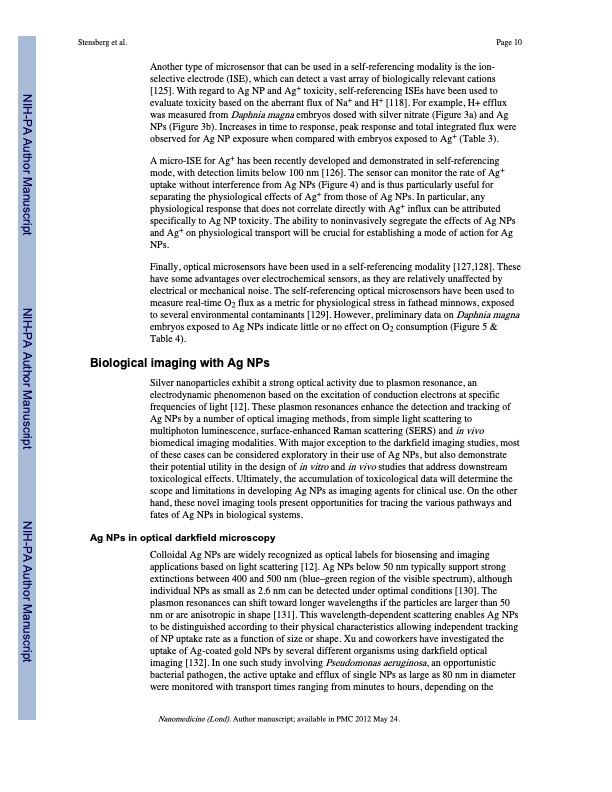
PDF Publication Title:
Text from PDF Page: 010
Stensberg et al. Page 10 Another type of microsensor that can be used in a self-referencing modality is the ion- selective electrode (ISE), which can detect a vast array of biologically relevant cations [125]. With regard to Ag NP and Ag+ toxicity, self-referencing ISEs have been used to evaluate toxicity based on the aberrant flux of Na+ and H+ [118]. For example, H+ efflux was measured from Daphnia magna embryos dosed with silver nitrate (Figure 3a) and Ag NPs (Figure 3b). Increases in time to response, peak response and total integrated flux were observed for Ag NP exposure when compared with embryos exposed to Ag+ (Table 3). A micro-ISE for Ag+ has been recently developed and demonstrated in self-referencing mode, with detection limits below 100 nm [126]. The sensor can monitor the rate of Ag+ uptake without interference from Ag NPs (Figure 4) and is thus particularly useful for separating the physiological effects of Ag+ from those of Ag NPs. In particular, any physiological response that does not correlate directly with Ag+ influx can be attributed specifically to Ag NP toxicity. The ability to noninvasively segregate the effects of Ag NPs and Ag+ on physiological transport will be crucial for establishing a mode of action for Ag NPs. Finally, optical microsensors have been used in a self-referencing modality [127,128]. These have some advantages over electrochemical sensors, as they are relatively unaffected by electrical or mechanical noise. The self-referencing optical microsensors have been used to measure real-time O2 flux as a metric for physiological stress in fathead minnows, exposed to several environmental contaminants [129]. However, preliminary data on Daphnia magna embryos exposed to Ag NPs indicate little or no effect on O2 consumption (Figure 5 & Table 4). Biological imaging with Ag NPs Silver nanoparticles exhibit a strong optical activity due to plasmon resonance, an electrodynamic phenomenon based on the excitation of conduction electrons at specific frequencies of light [12]. These plasmon resonances enhance the detection and tracking of Ag NPs by a number of optical imaging methods, from simple light scattering to multiphoton luminescence, surface-enhanced Raman scattering (SERS) and in vivo biomedical imaging modalities. With major exception to the darkfield imaging studies, most of these cases can be considered exploratory in their use of Ag NPs, but also demonstrate their potential utility in the design of in vitro and in vivo studies that address downstream toxicological effects. Ultimately, the accumulation of toxicological data will determine the scope and limitations in developing Ag NPs as imaging agents for clinical use. On the other hand, these novel imaging tools present opportunities for tracing the various pathways and fates of Ag NPs in biological systems. Ag NPs in optical darkfield microscopy Colloidal Ag NPs are widely recognized as optical labels for biosensing and imaging applications based on light scattering [12]. Ag NPs below 50 nm typically support strong extinctions between 400 and 500 nm (blue–green region of the visible spectrum), although individual NPs as small as 2.6 nm can be detected under optimal conditions [130]. The plasmon resonances can shift toward longer wavelengths if the particles are larger than 50 nm or are anisotropic in shape [131]. This wavelength-dependent scattering enables Ag NPs to be distinguished according to their physical characteristics allowing independent tracking of NP uptake rate as a function of size or shape. Xu and coworkers have investigated the uptake of Ag-coated gold NPs by several different organisms using darkfield optical imaging [132]. In one such study involving Pseudomonas aeruginosa, an opportunistic bacterial pathogen, the active uptake and efflux of single NPs as large as 80 nm in diameter were monitored with transport times ranging from minutes to hours, depending on the Nanomedicine (Lond). Author manuscript; available in PMC 2012 May 24. NIH-PA Author Manuscript NIH-PA Author Manuscript NIH-PA Author ManuscriptPDF Image | Toxicological studies on silver nanoparticles

PDF Search Title:
Toxicological studies on silver nanoparticlesOriginal File Name Searched:
nihms-316964.pdfDIY PDF Search: Google It | Yahoo | Bing
Turbine and System Plans CAD CAM: Special for this month, any plans are $10,000 for complete Cad/Cam blueprints. License is for one build. Try before you buy a production license. More Info
Waste Heat Power Technology: Organic Rankine Cycle uses waste heat to make electricity, shaft horsepower and cooling. More Info
All Turbine and System Products: Infinity Turbine ORD systems, turbine generator sets, build plans and more to use your waste heat from 30C to 100C. More Info
CO2 Phase Change Demonstrator: CO2 goes supercritical at 30 C. This is a experimental platform which you can use to demonstrate phase change with low heat. Includes integration area for small CO2 turbine, static generator, and more. This can also be used for a GTL Gas to Liquids experimental platform. More Info
Introducing the Infinity Turbine Products Infinity Turbine develops and builds systems for making power from waste heat. It also is working on innovative strategies for storing, making, and deploying energy. More Info
Need Strategy? Use our Consulting and analyst services Infinity Turbine LLC is pleased to announce its consulting and analyst services. We have worked in the renewable energy industry as a researcher, developing sales and markets, along with may inventions and innovations. More Info
Made in USA with Global Energy Millennial Web Engine These pages were made with the Global Energy Web PDF Engine using Filemaker (Claris) software.
Infinity Turbine Developing Spinning Disc Reactor SDR or Spinning Disc Reactors reduce processing time for liquid production of Silver Nanoparticles.
| CONTACT TEL: 608-238-6001 Email: greg@infinityturbine.com | RSS | AMP |